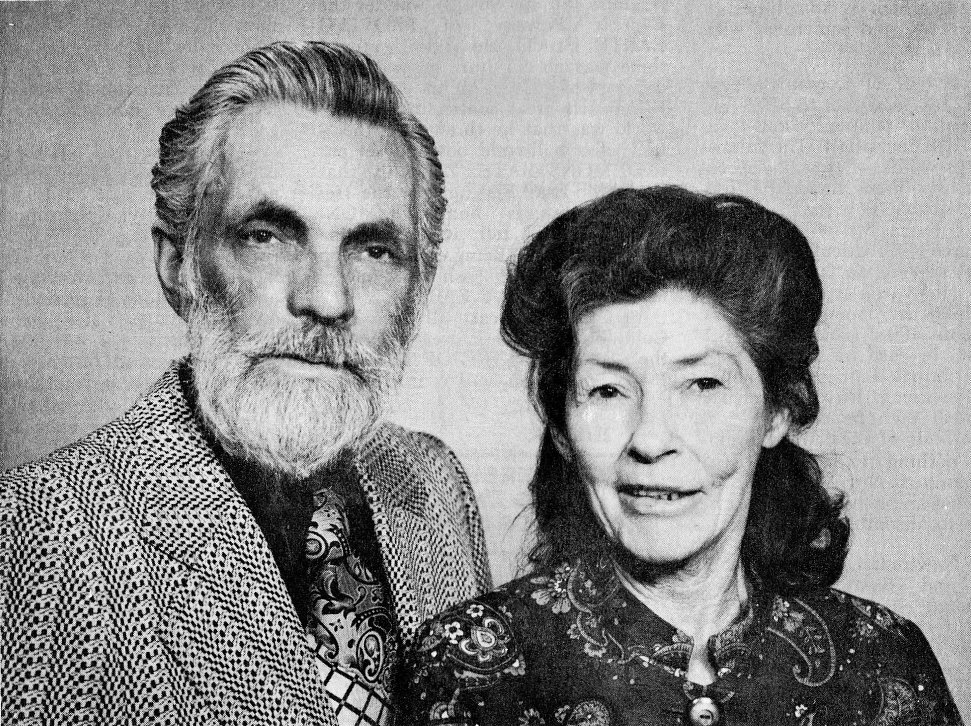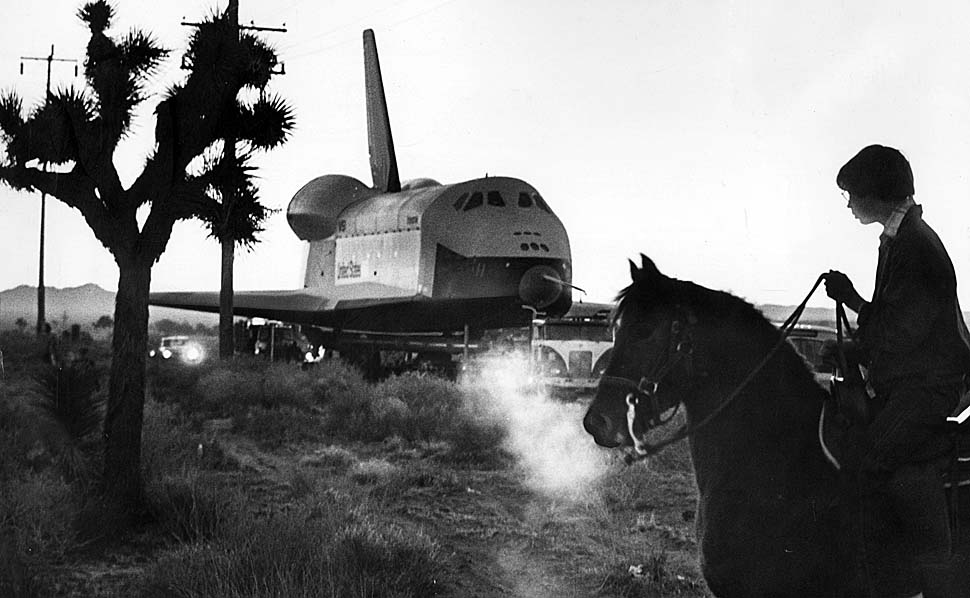“The Plane Truth” | Charles Johnson and the Flat Earth, December 1977

The Plane Truth
Here’s a guy who has some different thoughts about the shape the world is in. And he claims to be—pardon us—on the level.
By Robert Schadewald
December 1977
An isolated cottage overlooks the Mojave Desert from a ridge outside Lancaster, California. From this house among the Joshua trees—across 10 miles of sand and sagebrush from the giant Rockwell plant where the fleet of Space Shuttles is being built—comes the voice of Charles K. Johnson like that of a prophet crying in the wilderness, “Make flat the world of the Lord.”
Johnson is president of the International Flat Earth Research Society of America. A bearded, patriarchal looking man, he has lived in California for many years, but his soft baritone still has a touch of the Texas where he was born—on his father’s cattle ranch near Tennyson 53 years ago. He is a gentle man, whose sincere desire for tranquility seems at odds with his prophetic mission: to convince most of the rest of the world that the Earth is not a sphere.
The Shuttle factory across the desert doesn’t please Johnson. It represents yet another attempt to bolster the spherical fraud, another smoke screen to prevent people from seeing the “plane” truth.
“Nobody knows anything about the true shape of the world; it has no dimensions,” declares Johnson. “The known, inhabited world is flat, and, just as a guess, I’d say that the dome of heaven is about 4,000 miles away, and the stars are about as far as San Francisco is from Boston.”
The sun, Johnson says, is a small object, 32 miles across, that moves above the Earth—the Earth does not move. The moon is also about 32 miles across and doesn’t reflect the light of the sun; it gives off its own, altogether different, kind of light.
The universe is described in the Bible, though not very clearly, he says. His description: the known world is disc-shaped, with the North Pole at the center. There is an impassable ice barrier at the outer edge, the “southern limit.” Sailing around the world is just sailing in a circle. The sun and moon do it every day, circling above the Earth in the vicinity of the equator. Their apparent rising and setting are a trick of perspective, like a line of telegraph poles that seem s to disappear in the distance.
When Johnson was a schoolboy, his teacher tried to tell him otherwise. It didn’t work. “All the time I was going to school I questioned things,” he says. “In about the second grade, when they first presented the globe, it seemed completely unreasonable to me. I didn’t make a big issue of it then, but I never accepted it. You might say I’ve been a flat-Earther all my life.”
In 1941, Johnson read about Wilbur Glenn Voliva and his flat Earth organization in Zion, Illinois. He wrote immediately. Voliva sent him some information and encouragement, but in the confusion of World War II Johnson got sidetracked, and it wasn’t until the ’60s that he really became involved.
Johnson became an active member of the International Flat Earth Research Society, organized in England in 1956 by Samuel Shenton. The English news media had a lot of fun with Shenton, especially after the beginning of the space program. Because of the ridicule he suffered, Shenton became convinced that England was not the best place for a flat-Earth organization. So, when he died in 1971, it was his last wish that leadership of the society and his precious library of flat-Earth books should pass to Johnson.
Under Johnson’s leadership, the Society has signed up about 200 “hard-core” members from various backgrounds. “The largest group of members by profession consists of medical doctors,” says Johnson. “Then come lawyers. Ordinary people think it must be just some kooks somewhere that believe the Earth is flat, but it’s the professional people who believe it.”
Applicants become members if they agree never to defame the society and pay $7 in annual dues. They receive a membership card illustrated with a diagram showing the Earth is flat, and a year’s subscription to the Flat Earth News.
The Lancaster post office receives correspondence from all over the world addressed to “flat-Earthers,” or words to that effect. Johnson tries to answer all of it and says he doesn’t get much mail from cranks.
“The letters coming in now are all serious,” he says. “Oh, there’s one place in South Carolina from which someone writes a nasty letter every once in a while. And once or twice in the past few years, someone in Berkeley wrote some stupid thing. But practically all of our letters are from serious-minded people—if you’ll pardon the expression, upper-class people.”
Since moving to America, the International Flat Earth Research Society has gotten a better press. The society has been featured in the National Enquirer, and Johnson has appeared on many local radio talk shows, plus NBC Radio’s Monitor program. He is generally pleased with the coverage. “The news media seeks us out a lot,” he says. “We’re very much in favor of the American free press. They’ve given full coverage to the flat-Earth movement and never hurt us at all.”
Johnson occasionally makes personal appearances to promote his views. He has addressed the students at Beverly Hills High School, and last year he was invited to the World Tomorrow Fair, an annual symposium on the future held at the University of Massachusetts in Amherst. Others invited included consumer advocate Ralph Nader and futurist Herman Kahn.
“I wasn’t prepared for what happened. The car broke down and I didn’t make it,” Johnson says sadly, recalling the failure of his 1959- model auto. “Boy, what a lost opportunity!”
The future is the business of a prophet, and Johnson has strong views on how the world’s problems should be solved. “We need to find a way to function together without killing one another,” he says. “The Bible is a great tangle of history and corruption and so forth, but the aim of it all is a one-world, flat-Earth society, for honesty and decency and that sort of thing. Peace and tranquility will be established by law, and no one will bother you about religion, creed, color or anything else.”
But first, this “Last Iconoclast,” as he sometimes calls himself, says we must dispose of the globe. “The spinning ball dogma began when Henry VIII established the Church of England,” he says. “Prior to that, it had been more or less understood that the Earth is flat. We’re going to shatter this false [global] doctrine, and we’re calling on whomsoever will join us.”
Evidence for the flat shape of the Earth is not lacking, Johnson maintains. He has personally checked Lake Worth, near Fort Worth, Texas, and Lake Tahoe, on the California-Nevada border, and he says both are flat.
“The fact that we can prove water flat is the basic, foundation proof,” he says. But there’s other evidence, including the testimony of his wife Marjory, who is from Australia. “She’s sworn out an affidavit that she never hung by her feet in Australia,” he says. “She sailed a ship over here, and she did not get on it upside down and she did not sail straight up. She sailed right straight across the ocean. We consider that a very important proof that the world is flat.”
The flat-Earth idea has been accepted by those “running the world,” Johnson declares. “The United Nations is a flat-Earth organization. They’re using our map [a polar azimuthal equidistant projection], you know.”
But it’s difficult to get the message through to the rest of the world, and Johnson accepts such frustration as part of his role as a prophet. “People prefer lies to the truth,” he says.
The space program? It’s a fraud to keep the common people in the dark, he contends, citing the Apollo moon program as an example. “It was a movie version of the way things might be if the spherical theory were right,” says Johnson. “Arthur C. Clarke wrote it and directed it. But he knows the Earth is flat. Shenton had the whole flat-Earth thing shown to him [Clarke] in England.”
The space program is not without value, however. “It’s kind of a WPA project,” says Johnson. “Of the tens of thousands of people here in the United States who know the Earth is flat, many support it because it provides jobs.”
NASA’s next major assault on the flat-Earth idea will come in early 1979, when the first Space Shuttle is launched into “orbit,” but Johnson is not very concerned. It doesn’t take much of a prophet, he says, to see that the space program is losing its punch.
“When Evel Knievel claimed to ride a rocket for a mile—not millions of miles, just a mile—he was the greatest hero in the land,” says Johnson. “The whole country went wild over it. It was an utter rejection of the space program.
“We’d just seen pictures of these jokers, these Rover Boys, supposedly way out in space, working on their spaceship with their trusty pliers and playing golf on the moon. You can’t find a kid anywhere who will even mention such gibberish.
“Evel Knievel, they like.”

If you enjoyed this article, then consider becoming a Patron here at The Unexpected Cosmology! With Patron status, you will be able to access and download ALL of the Archived articles here on TUC!